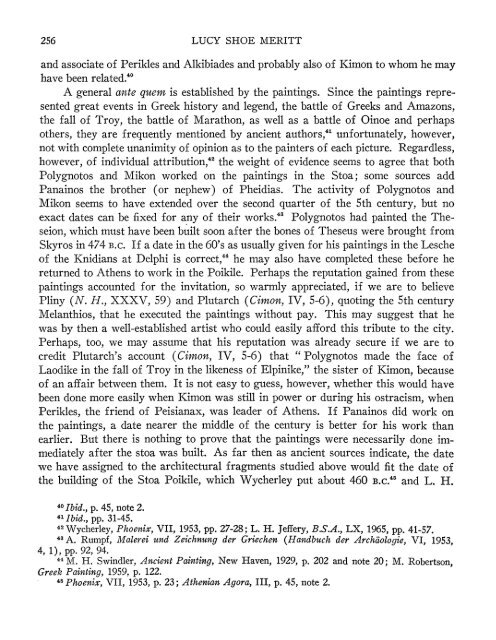the stoa poikile - The American School of Classical Studies at Athens
the stoa poikile - The American School of Classical Studies at Athens
the stoa poikile - The American School of Classical Studies at Athens
You also want an ePaper? Increase the reach of your titles
YUMPU automatically turns print PDFs into web optimized ePapers that Google loves.
256 LUCY SHOE MERITT<br />
and associ<strong>at</strong>e <strong>of</strong> Perikles and Alkibiades and probably also <strong>of</strong> Kimon to whom he may<br />
have been rel<strong>at</strong>ed.40<br />
A general ante quem is established by <strong>the</strong> paintings. Since <strong>the</strong> paintings represented<br />
gre<strong>at</strong> events in Greek history and legend, <strong>the</strong> b<strong>at</strong>tle <strong>of</strong> Greeks and Amazons,<br />
<strong>the</strong> fall <strong>of</strong> Troy, <strong>the</strong> b<strong>at</strong>tle <strong>of</strong> Mar<strong>at</strong>hon, as well as a b<strong>at</strong>tle <strong>of</strong> Oinoe and perhaps<br />
o<strong>the</strong>rs, <strong>the</strong>y are frequently mentioned by ancient authors,4' unfortun<strong>at</strong>ely, however,<br />
not with complete unanimity <strong>of</strong> opinion as to <strong>the</strong> painters <strong>of</strong> each picture. Regardless,<br />
however, <strong>of</strong> individual <strong>at</strong>tribution,42 <strong>the</strong> weight <strong>of</strong> evidence seems to agree th<strong>at</strong> both<br />
Polygnotos and Mikon worked on <strong>the</strong> paintings in <strong>the</strong> Stoa; some sources add<br />
Panainos <strong>the</strong> bro<strong>the</strong>r (or nephew) <strong>of</strong> Pheidias. <strong>The</strong> activity <strong>of</strong> Polygnotos and<br />
Mikon seems to have extended over <strong>the</strong> second quarter <strong>of</strong> <strong>the</strong> 5th century, but no<br />
exact d<strong>at</strong>es can be fixed for any <strong>of</strong> <strong>the</strong>ir works.43 Polygnotos had painted <strong>the</strong> <strong>The</strong>seion,<br />
which must have been built soon after <strong>the</strong> bones <strong>of</strong> <strong>The</strong>seus were brought from<br />
Skyros in 474 B.C. If a d<strong>at</strong>e in <strong>the</strong> 60's as usually given for his paintings in <strong>the</strong> Lesche<br />
<strong>of</strong> <strong>the</strong> Knidians <strong>at</strong> Delphi is correct,44 he may also have completed <strong>the</strong>se before he<br />
returned to A<strong>the</strong>ns to work in <strong>the</strong> Poikile. Perhaps <strong>the</strong> reput<strong>at</strong>ion gained from <strong>the</strong>se<br />
paintings accounted for <strong>the</strong> invit<strong>at</strong>ion, so warmly appreci<strong>at</strong>ed, if we are to believe<br />
Pliny (N. H., XXXV, 59) and Plutarch (Cimon, IV, 5-6), quoting <strong>the</strong> 5th century<br />
Melanthios, th<strong>at</strong> he executed <strong>the</strong> paintings without pay. This may suggest th<strong>at</strong> he<br />
was by <strong>the</strong>n a well-established artist who could easily afford this tribute to <strong>the</strong> city.<br />
Perhaps, too, we may assume th<strong>at</strong> his reput<strong>at</strong>ion was already secure if we are to<br />
credit Plutarch's account (Cimon, IV, 5-6) th<strong>at</strong> " Polygnotos made <strong>the</strong> face <strong>of</strong><br />
Laodike in <strong>the</strong> fall <strong>of</strong> Troy in <strong>the</strong> likeness <strong>of</strong> Elpinike," <strong>the</strong> sister <strong>of</strong> Kimon, because<br />
<strong>of</strong> an affair between <strong>the</strong>m. It is not easy to guess, however, whe<strong>the</strong>r this would have<br />
been done more easily when Kimon was still in power or during his ostracism, when<br />
Perikles, <strong>the</strong> friend <strong>of</strong> Peisianax, was leader <strong>of</strong> A<strong>the</strong>ns. If Panainos did work on<br />
<strong>the</strong> paintings, a d<strong>at</strong>e nearer <strong>the</strong> middle <strong>of</strong> <strong>the</strong> century is better for his work than<br />
earlier. But <strong>the</strong>re is nothing to prove th<strong>at</strong> <strong>the</strong> paintings were necessarily done immedi<strong>at</strong>ely<br />
after <strong>the</strong> <strong>stoa</strong> was built. As far <strong>the</strong>n as ancient sources indic<strong>at</strong>e, <strong>the</strong> d<strong>at</strong>e<br />
we have assigned to <strong>the</strong> architectural fragments studied above would fit <strong>the</strong> d<strong>at</strong>e <strong>of</strong><br />
<strong>the</strong> building <strong>of</strong> <strong>the</strong> Stoa Poikile, which Wycherley put about 460 B.C.45 and L. H.<br />
40 Ibid., p. 45, note 2.<br />
41Ibid., pp. 31-45.<br />
42Wycherley, Phoenix, VII, 1953, pp. 27-28; L. H. Jeffery, B.S.A., LX, 1965, pp. 41-57.<br />
43 A. Rumpf, Malerei und Zeichnung der Griechen (Handbuch der Archdologie, VI, 1953,<br />
4, 1), pp. 92, 94.<br />
44 M. H. Swindler, Ancient Painting, New Haven, 1929, p. 202 and note 20; M. Robertson,<br />
Greek Painting, 1959, p. 122.<br />
45 Phoenir, VII, 1953, p. 23; A<strong>the</strong>nian Agora, III, p. 45, note 2.

















